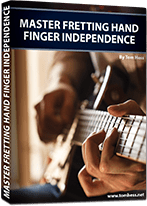How To Fix Flailing Fretting Hand Fingers In Your Guitar Technique
Feel Incredibly Easy

EMAIL TO GET ACCESS
By submitting your info, you agree to send it to Tom Hess Music Corporation who will process and use it according to their privacy policy.
So, you got a bad case of flailing fingers on guitar and you want to know what to do about it?
You’re in the right place.
This guitar technique article will show you how to improve your finger independence and calm down your flailing fingers.
And when you do…
… you’ll have a much easier time learning to play guitar fast.
Heads up:
This finger independence training process *will* take some work and you won’t fix your flailing fingers overnight.
But the good news is:
If you simply follow the guitar technique training process I lay out below…
…calming down your flailing fingers (and playing guitar fast) becomes surprisingly simple.
To begin...
...watch the guitar technique video below to see how to control your flailing fingers.
Now that you know the basics of taming your flailing fingers…
…here are 5 more guitar technique tips that help you develop finger independence and learn to play guitar fast:
Feel Incredibly Easy

EMAIL TO GET ACCESS
By submitting your info, you agree to send it to Tom Hess Music Corporation who will process and use it according to their privacy policy.
Guitar Technique Tip #1: Practice Training Your Finger Independence Far Slower Than You Practice Other Elements Of Guitar Technique
Every guitar player who wants to improve their guitar technique is familiar with “slow practice”.
But when it comes to calming down your flailing fingers and developing your finger independence…
…you have to practice this area of guitar technique way slower than you practice most other exercises.
How slowly should you practice this element of your guitar technique?
For one thing, you should turn off the metronome.
Believe it or not, your metronome could hurt your ability to train your finger independence (and play guitar fast).
Here is why:
1. The metronome click diverts some of your attention to playing in time instead of controlling your guitar technique.
This makes it much harder to fix the root causes of your flailing fingers and get your fingers to do what you want them to do.
2. You sometimes need to slow way down even below the slowest tempo of the metronome to improve your finger independence. (Whether or not you need to do this depends on the severity of your finger independence issues.)
Want to see how slowly you sometimes need to practice to improve your guitar technique?
Watch this video:
Question: “Tom Hess, what other elements of my guitar technique should I practice without a metronome?”
Answer: It’s usually a good idea to practice fixing any bad guitar technique habit without a metronome. That’s because bad guitar technique habits (whether they are related to flailing fingers in your fretting hand or something in your picking hand) often need your full attention.
So, anytime you’re trying to change something in your guitar technique, spend some time playing without a metronome.
Ironically, this kind of ultra-slow practicing is what gives you the ability to play guitar fast later.
Question: “Tom Hess, at what point should I begin practicing guitar technique with a metronome?”
Answer: Practice this element of your guitar technique without a metronome for the first 4-7 days.
After that…
…rotate between metronome practice and metronome-free practice. You can do it in the same guitar technique practice session.
For example: spend 2-4 minutes focusing on controlling your flailing fingers without a metronome.
After you spend 2-4 minutes drilling the new guitar technique habit (that will enable you to play guitar fast later), spend 1-2 minutes playing with a metronome.
This will test how well you are able to keep your flailing fingers under control when you put some pressure on your guitar playing mechanism. (By using a metronome.).
Go back and forth between 2-4 minutes of practicing guitar technique without a metronome and 1-2 minutes practicing controlling your flailing fingers with a metronome.
This way of practicing helps prepare your hands to play guitar fast.
Set the metronome to tempos that are just fast enough to be challenging, but slow enough to stay in control of your flailing fingers.
Guitar Technique Tip #2: Isolate Your Fretting Hand As You Practice Controlling Your Flailing Fingers.
You probably know how important it is to isolate the notes of a difficult lick as you work to improve your guitar technique and play guitar fast.
But have you ever tried (or even heard about) isolating the motions of each hand?
No?
Then you’ve been missing out on a great way to fix problems in your guitar technique, gain control over your flailing fingers and learn to play guitar fast.
Watch this video to see how powerful isolating the motions of each hand can be in helping you improve your guitar technique and play guitar fast:
Here is how isolating each hand works in the case of finger independence:
You isolate your fretting hand and simply rest your picking hand on the strings (don’t hit the notes with the pick).
Focus on doing the fretting motions slowly (and perfectly) enough to control your flailing fingers and train your guitar technique.
This is another reason why you sometimes want to practice your guitar technique without a metronome
Question: “Tom Hess, does this mean I need to train my finger independence by doing legato?”
Answer: No, it doesn't mean that at all. When you isolate your fretting hand, you fret notes as you normally would, with no sound coming from the notes.
The benefit of this is you get to work on controlling flailing fingers in total isolation.
Your only goal is to train the guitar technique motions, without being distracted by: the sound of the notes, string noise, metronome clicks or picking hand coordination.
When you give your full attention to training the guitar technique elements I talked about in the finger independence video you saw – getting your flailing fingers to behave properly becomes easy.
Few guitar players ever focus on training their guitar technique this way. That is why gaining control over their flailing fingers takes a long time for most people.
But if you follow the guitar technique advice here - you won’t be one of them.
This ability to properly isolate and refine the motions of one hand at a time is one of the key elements of playing guitar fast.

Guitar Technique Tip #3: Control Excess Muscle Tension In Your Guitar Technique
Excess muscle tension kills your ability to play guitar fast and clean. And it certainly makes it hard to control your flailing fingers.
How do you control excess tension in your guitar technique?
Simple: do a tension audit throughout your body.
Like this:
As you play any note, run through your entire body mentally and check for tension everywhere.
The most obvious body part to relax is your flailing fingers. That’s the only way to get them to come down closer to the strings.
(One easy way to check for finger independence is to feel your fretting hand fingers with your picking hand.
If you can wiggle your fingers – it means your guitar technique is quite relaxed and your flailing fingers are coming under your control.)
But that’s not all.
You also need to relax: your jaw, your neck, your shoulders, biceps, your fretting hand thumb (more on this below), your picking grip, your stomach, thighs, calves and feet.
 Become A Better Lead Guitarist
Become A Better Lead GuitaristLearn the key factor for how to
become a better lead guitarist.
 How To Play Killer Guitar Vibrato
How To Play Killer Guitar VibratoImprove your vibrato technique
by watching a killer guitar video.
 Improve Your Lead Guitar Solos
Improve Your Lead Guitar SolosLearn how to immediately play
killer lead guitar solo phrases.
Question: “Tom Hess, that’s a lot of stuff to remember just to fix one guitar technique problem! How can I possibly focus on all of these elements as I work on my finger independence?”
Answer: Simple. Use a method called “focus rotation”. It’s where you only focus on one element of guitar technique (or finger independence or tension control) at a time.
For example: focus for 1 minute just on relaxing your jaw. Then, focus for 1 minute on controlling your shoulders. Then – your stomach. Then – your feet, etc.
This way, you’re only focusing on one element of guitar technique at a time. But over the course of just 15-20 minutes, you can cover a lot of ground that makes it easier to improve your guitar technique and play guitar fast.
And when it comes to controlling your flailing fingers?
You can use focus rotation to just focus on one finger at a time. Spend 1 minute focusing just on the index finger. Then rotate focus and only focus on the middle finger.
Focus rotation is a genius way to improve just about any area of guitar technique (and it works particularly great for finger independence).
You can even apply focus rotation to focusing to different notes of a guitar technique exercise.
Watch this video to see what I mean:
Guitar Technique Tip #4: Fix Your Thumb Position
One of the key elements of finger independence is (believe it or not)…
…your fretting hand thumb.
(Note: the guitar technique advice below is about playing most guitar scales and arpeggios – NOT about string bending and vibrato.)
The BIG mistake most guitar players make (that causes their flailing fingers problem and makes it hard to improve their guitar technique) is…
Curling the thumb around the back of the guitar neck with your fretting hand. (Or letting it point towards the head of the guitar - parallel with the guitar neck).
Here is why this is bad:
When your thumb is in either of the above positions, your fretting hand fingers are in a closed position (see what this looks like below). That means it takes more effort to fret notes and do hammer ons and pull offs as you play guitar.
But the solution (for your guitar technique) is quite simple:
When you are playing between frets 1 and fret 13 (or so), concentrate on keeping your thumb roughly behind the middle finger of your fretting hand.
(If it’s a bit closer to the index finger or the ring finger – that’s ok.)
The thumb should point up (towards the ceiling).
This position makes your guitar technique feel effortless, helps you develop your finger independence and enables you to play guitar fast.
Watch this video to see how to do this in detail:
Question: “But Tom Hess, what if I'm playing on the higher frets of the guitar? How should I position my thumb then?”
Answer: On the higher frets, you can position your thumb almost any way you want. Since the frets are so close together – it won’t get in the way of your ability to play guitar fast.
That said, make sure you can maintain proper thumb position when playing in the middle and lower parts of the fretboard. Your ability to do that is what helps you not only tame your flailing fingers, but also play guitar fast with all guitar techniques.
Question: “But Tom Hess, what about great guitar players (like Yngwie Malmsteen or Paul Gilbert) who often play guitar fast with their fretting hand thumb wrapped around the neck of the guitar?”
Answer: Their unusually large hand size makes them the exception to some general guitar technique “rules”. That said, the thumb position I described will help most people who struggle with finger independence to start playing guitar fast.
Guitar Technique Tip #5: Don’t Put The Rest Of Your Playing On Hold To Fix Flailing Fingers.
No single part of your guitar technique is more important than the rest of your guitar playing.
So, no matter how bad you think your case of flailing fingers is…
… and no matter how much you may want to play guitar fast…
… remember that there are other skills you need to develop on top of guitar technique.
Schedule some part of your guitar practice time to work on finger independence, but spend the majority of your guitar practice on other skills.
Those other skills could be: other elements of guitar technique or other musical skills, like: music theory, ear training, guitar phrasing, fretboard knowledge or songwriting and improvising.
This way you benefit much more from finally conquering your challenges with flailing fingers. And when you are able to play guitar fast, you can use your guitar technique in more expressive ways.
Question: “Tom Hess, what’s the best way to schedule “working on flailing fingers” into my guitar practice schedule?”
Answer: Work on finger independence every day in short blocks of highly focused practice time. Finger independence is a skill that needs frequency – not duration.
All that said...
There is one other thing you have to know about finger independence that can save you a ton of grief and frustration.
Let me explain by telling you a quick story:
I recently talked to a guitar player who was dead-set on hiring me to teach him 1-1 (@ my $300/hour rate, with a minimum 4-hour commitment) to fix his “nagging flailing pinkie”.
As I required, he sent me a short video of his playing beforehand – zoomed in on his fretting hand as he played some licks.
But after taking 1 look at it, I replied:
“I just saved you $1200. You don’t have a flailing pinkie problem. No need to hire me 1-1.”
What happened next though, was kind of unexpected.
Undeterred – he sent me ANOTHER video (this time – with the camera looking down at his hand over his shoulder) and commented:
“You don’t understand. I DO have it... look from this angle.”
LOL. Talk about the boy crying wolf flailing pinkie.
Here is the thing:
Many parts of your guitar technique look different depending on the angle from which you watch your hands.
Flailing pinkie (and flying fingers in general) is one example. (When you watch your fingers from the top down, your fingers will look like they are flailing... but when you watch OTHERS play (from the front), you don’t see that same issue in their playing.)
This can send you on a wild witch hunt where you waste time and money fixing “problems” that don’t exist.
Meanwhile, ignoring the REAL things keeping you stuck.
Such is the fate of those who self-diagnose their guitar playing problems.
That’s why one of the best ways to refine your technique is to get feedback from an expert guitar teacher who can show you not only what is keeping you stuck, but also give you needle-moving solutions that help you improve your guitar technique fast.
Watch this video to see how quickly a good teacher can help you pinpoint the nonobvious causes of your guitar technique problems:
Now you know what it takes to calm down your flailing fingers and improve your guitar technique.
But believe it or not…
… this is only scratching the surface of the topic of fretting hand independence.
If you want to build more guitar speed with your fretting hand, you’ll love my new free eGuide called: mastering fretting hand finger independence for guitar players. It’s free and it goes much deeper into the details of fretting hand finger independence training. These details help you even more with controlling your flailing fingers and learning to play guitar fast.
Best part is, it does this without a lot of practice. Download your copy today and discover guitar speed secrets few guitarists will know.

TO EFFORTLESS FINGER
INDEPENDENCE FOR
YOUR FRETTING HAND

Become a better guitar player by studying with the best rock guitar tutor online.

